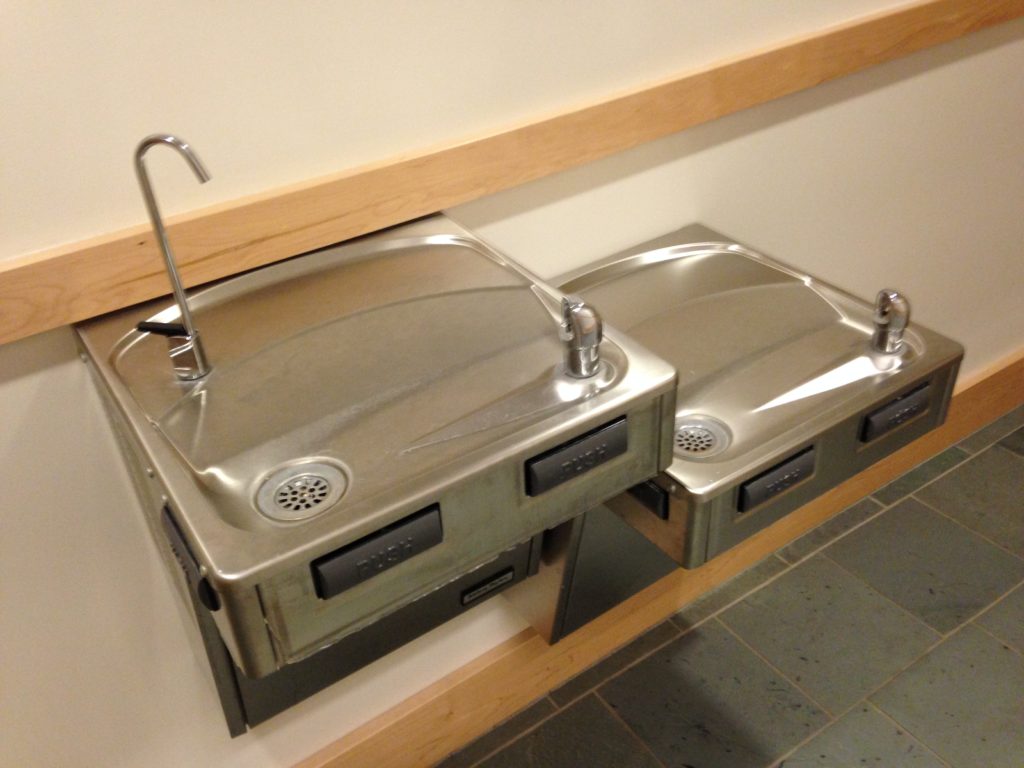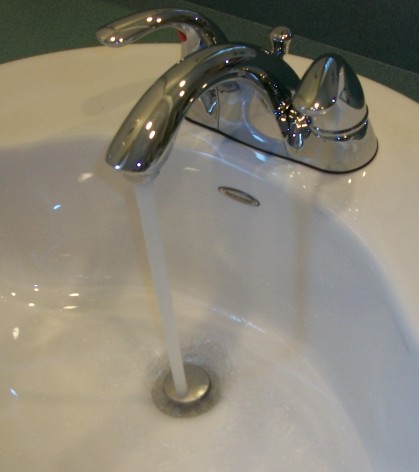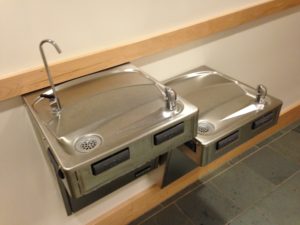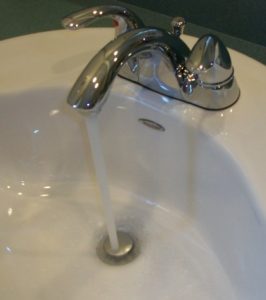The very schools we depend on to educate our children could be making them less smart.
Drinking water in schools across Massachusetts, including here in the Pioneer Valley, has been found to contain lead significantly exceeding safety standards. Lead exposure, experts say, can cause lower IQ, increased attention deficit hyperactivity disorder, and other cognitive problems.
Yet many parents don’t realize that a great part of the responsibility for making sure the problem gets fixed lies with them – not with government rules, says Yanna Lambrinidou, an expert on lead in drinking water
“The moment the parents turn their gaze away, school districts stop addressing the problem,” says Lambrinidou, who is an affiliate faculty member in the Department of Science and Technology in Society at Virginia Tech.
Lambrinidou has worked on the lead crises recently in Flint, Michigan, and in 1994 in Washington, D.C. She has also served on federal advisory committees on lead. She’s an outspoken critic of current approaches to lead management in drinking water, and visited Smith College in April to talk about the problem.
Even when lead is discovered, there are no state or federal regulations for how schools must respond, according to Ed Coletta, public affairs director for the Massachusetts Department of Environmental Protection. Municipalities are left to handle the lead in whatever way they see fit – which critics say can include ignoring the problem.
And unfortunately, no federal funding assistance and limited state help are available to communities. To make matters worse, despite growing public concern over drinking water quality, the Trump administration is seeking deep cuts to the Clean Water Act and the few existing grant programs for water infrastructure.
The question for us, then, is “Now what?”
Towns in the Pioneer Valley with at least one school drinking water tap found to exceed federal standards include Amherst, Belchertown, Bernardston, Charlemont, Chesterfield, Chicopee, Colrain, Conway, East Longmeadow, Easthampton, Erving, Greenfield, Hampden-Wilbraham, Holyoke, Monson, Northfield, Orange, Pelham, Shelburne Falls, South Deerfield, Southampton, Southwick, Springfield, Ware, West Springfield, and Westhampton.
And remember: the testing program is voluntary, so not all schools participated.
Statewide, the highest lead level at a single tap is reported at a whopping 42,000 parts per billion at North Quincy High School, according to a spreadsheet published on the MassDEP website – far above the federal action level of 15 ppb, and exceeding even the EPA hazardous waste standard of 5,000 ppb.
In the Pioneer Valley, the highest values were found in select taps at Thornton Burgess (6,100 ppb) and Wilbraham Middle Schools (1,600 ppb) in Hampden-Wilbraham, and at Morgan Full Service Community School (4,300 ppb) in Holyoke.
The lead contamination was discovered through a $2.75 million testing program by the Massachusetts Department of Environmental Protection. The program began as a response to the lead crisis in Flint.
No state or federal requirement mandates comprehensive testing of school drinking water taps for lead. Massachusetts’ voluntary program is “as far as we know, first in the nation,” says Coletta.
Because the program is voluntary, only just over half of Massachusetts’ 1,800 schools participated. A startling 604 of them had one or more water taps with lead levels above the federal action level of 15 parts per billion.
Each tap was sampled twice during a single sampling visit. Because lead accumulates in pipes overnight, the first sample contained most of the lead.
Lead in school drinking water likely comes from lead-containing fittings in plumbing systems on school property, rather than from regularly monitored water supplies.
Almost all the taps tested gave lead-free water after a 30-second flush. Actions taken at schools so far include shutting down some high-lead taps, creating a daily flushing program for others, and notifying parents. The state is keeping a record of all actions taken to date, which concerned parents can find on the MassDEP website.
But are these measures enough?
While flushing addresses the most likely high lead concentrations, Lambrinidou says, taps can release lead even afterwards. She also points out that because each tap in the Massachusetts program is tested during only one sampling visit, the program may miss taps that release lead only occasionally.
“Lead solder and lead rust can flake off at any time, and it’s totally unpredictable when that can happen,” she says. “A one-time test is unable to tell you how much lead can come out of that tap.”
It turns out that even fittings that can be marketed as “lead-free” by federal regulations contain enough lead to cause drinking water to exceed federal action levels.
Critics including Lambrinidou have also said that even the federal 15 ppb action level may not fully protect children. The American Association of Pediatrics has concluded that no level of lead in blood is safe for kids.
Blood lead levels as low as 13 ppb in children can yield higher risk of ADHD and, in adults, higher risk of renal failure or miscarriage, the AAP reports. While blood lead concentration isn’t directly related to exposure levels, the AAP recommends reducing lead exposure to the extent possible to avoid increased blood lead content.
“The best ‘treatment’ for lead poisoning is to prevent any exposure before it happens,” said Jennifer Lowry, chair of the AAP Council on Environmental Health. “Most existing lead standards fail to protect children. They provide only an illusion of safety.”
The report does point out lead paint and lead paint dust from older homes are still the primary exposure source for kids, especially younger than 6 years old. Children are less likely to drink enough water at school to accumulate significant lead in their blood.
The Massachusetts testing program did not include funding to investigate current blood lead levels in school-aged kids statewide, notes David Reckhow, a civil and environmental engineering professor at the University of Massachusetts who collaborated with the state on the lead project. That means the health impact so far of lead from school drinking water and other sources is unknown.
Reckhow says the high lead levels in school taps have him “concerned.” He noted that some of the highest levels could be in error, as the data has not yet been vetted. But for the highest-lead taps, he said flushing is unlikely to suffice.
Relying exclusively on local communities to address lead will not be enough, said Reckhow.
“If you leave it up to local control, the wealthy communities will solve the problem, and the poor communities won’t be able to,” he said. “I think we need a broader program to do this, and that means state level, federal level.”
The highest lead taps should ideally be resampled, and/or put out of service until their plumbing is investigated and any lead-containing fixtures replaced. Eventually, he said, schools should look toward replacing all lead-containing fittings in their plumbing. But that’s an expensive option, especially if done all at once.
Until plumbing is replaced, lead filters or hand-held lead testing devices could help ensure low lead concentration, he said.
In Flint, many residents turned to bottled water. But bottled water is pricey, at a wholesale cost of about $1.20 per gallon – 2,000 times more expensive than tap water.
Filters waste less plastic and could cost less. Though initially expensive at $70-$450 per tap, replacement cartridges are cheaper, so unlike bottled water, the highest costs would be one-time only.
Such filters do have to be carefully maintained. If cartridges aren’t replaced regularly, they can release the lead they’ve stored. Still, says Lambrinidou, well-maintained filters could offer more certainty that lead is being kept from reaching kids.
Parents should educate themselves about the lead in their towns and options for addressing school taps. Complete lead testing results can be found at the Massachusetts DEP website, along with mitigation actions selected for each tap and school.
Moreover, the federal Lead and Copper Rule, which dictates acceptable lead levels and testing schedules, is up for revision this year. People concerned about lead exposure should consider weighing in on the rule through phone calls and letters to the EPA.
Threatened drinking water protection programs, including the Clean Water Act, also need public support and comment. For instance, Trump’s proposed federal budget would cut a $498 million U.S. Department of Agriculture effort, the Water and Wastewater Loan and Grant Program, which helps rural communities upgrade and fix water infrastructure.
Communities like Flint, Michigan, and now here in our own state, are canaries in the coal mine when it comes to lead in drinking water across the U.S.
Here in Massachusetts, we’re fortunate to have a government that’s made a beginning in quantifying and addressing the problem. Kids in schools nationwide, at least so far, aren’t so lucky – and as a nation, that’s not a smart choice.
Naila Moreira is a writer and poet who focuses on science, nature and the environment in this monthly column. She teaches science writing at Smith College and is the writer in residence at Forbes Library. She’s on Twitter @nailamoreira.









